2025 NFL Fifth-Year Option Tracker
NFL teams have until May 2 to officially pick up fifth-year options on 2021 first-rounders. The 2020 CBA revamped the option structure and made them fully guaranteed, rather than guaranteed for injury only. Meanwhile, fifth-year option salaries are now determined by a blend of the player’s position, initial draft placement and performance- and usage-based benchmarks:
- Two-time Pro Bowlers (excluding alternates) will earn the same as their position’s franchise tag
- One-time Pro Bowlers will earn the equivalent of the transition tag
- Players who achieve any of the following will receive the average of the third-20th-highest salaries at their position:
- At least a 75% snap rate in two of their first three seasons
- A 75% snap average across all three seasons
- At least 50% in each of first three seasons
- Players who do not hit any of those benchmarks will receive the average of the third-25th top salaries at their position
With the deadline looming, we will use the space below to track all the option decisions from around the league:
- QB Trevor Lawrence, Jaguars ($25.66MM): Exercised
- QB Zach Wilson, Broncos* ($22.41MM): Declined
- QB Trey Lance, Cowboys** ($22.41MM): Declined
- TE Kyle Pitts, Falcons ($10.88MM): Exercised
- WR Ja’Marr Chase, Bengals ($21.82MM): Exercised
- WR Jaylen Waddle, Dolphins ($15.59MM): Exercised
- T Penei Sewell, Lions ($19MM): Extended through 2029
- CB Jaycee Horn, Panthers ($12.47MM): Exercised
- CB Patrick Surtain, Broncos ($19.82MM): Exercised
- WR DeVonta Smith, Eagles ($15.59MM): Extended through 2028
- QB Justin Fields, Steelers*** ($25.66MM): Declined
- DE Micah Parsons, Cowboys ($21.32MM): Exercised
- T Rashawn Slater, Chargers ($19MM): Exercised
- OL Alijah Vera-Tucker, Jets ($13.31MM): Exercised
- QB Mac Jones, Jaguars**** ($25.66MM): Declined
- LB Zaven Collins, Cardinals ($13.25MM): Declined
- T Alex Leatherwood, Raiders: N/A
- LB Jaelan Phillips, Dolphins ($13.3MM): Exercised
- LB Jamin Davis, Commanders ($14.48MM): Declined
- WR Kadarius Toney, Chiefs***** ($14.35MM): Declined
- DE Kwity Paye, Colts ($13.4MM): Exercised
- CB Caleb Farley, Titans ($12.47MM): Declined
- T Christian Darrisaw, Vikings ($16MM): Exercised
- RB Najee Harris, Steelers ($6.79MM): Declined
- RB Travis Etienne, Jaguars ($6.14MM): Exercised
- CB Greg Newsome, Browns ($13.38MM): To be exercised
- WR Rashod Bateman, Ravens ($14.35MM): N/A; extended through 2026
- DE Payton Turner, Saints ($13.39MM): Declined
- CB Eric Stokes, Packers ($12.47MM): Declined
- DE Greg Rousseau, Bills ($13.39MM): Exercised
- LB Odafe Oweh, Ravens ($13.25MM): Exercised
- LB Joe Tryon-Shoyinka, Buccaneers ($13.25MM): Declined
* = Jets traded Wilson on April 22, 2024
** = 49ers traded Lance on August 25, 2023
*** = Bears traded Fields on March 16, 2024
**** = Patriots traded Jones on March 10, 2024
***** = Giants traded Toney on October 27, 2022
Revisiting 2021 First-Round QB Picks
With the 2024 draft approaching, this year’s crop of quarterbacks will increasingly become the center of attention around the NFL. Acquiring rookie passers is viewed as the surest route to long-term success, and the urgency teams feel to generate quick rebuilds fuels aggressive moves aimed at acquiring signal-callers deemed to have high upside.
Each class is different, though, and past drafts can offer a cautionary tale about the downfalls of being overly optimistic regarding a young quarterback. In the case of the 2021 draft, five signal-callers were selected on Day 1, and to varying extents things have not gone according to plan in each case. Three quarterbacks (quite possibly four, depending on how the immediate future plays out) have been traded, while the other has not lived up to expectations.
Here is a breakdown of all five QBs taken in the first round three years ago:
Trevor Lawrence (No. 1 overall, Jaguars)
Lawrence entered the league with enormous expectations after his high school and college success, having been touted as a generational prospect. The Clemson product (like the rest of the Jaguars) endured a forgettable season under head coach Urban Meyer as a rookie, however. The latter’s firing paved the way for the arrival of Doug Pederson, known to be a QB-friendly coach. Lawrence improved in 2022, earning a Pro Bowl nod and helping guide the team to the divisional round of the postseason. 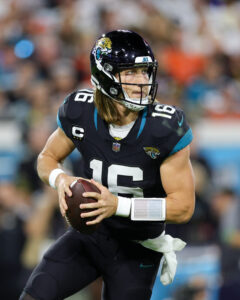
This past campaign saw the 24-year-old battle multiple nagging injuries, and he was forced to miss a game for the first time in his career. Jacksonville failed to find a rhythm on offense throughout the year, and a late-season slump left the team out of the playoffs altogether after a division title seemed to be in hand. In two seasons under Pederson, Lawrence has totaled 46 touchdown passes and 22 interceptions – figures which fall short of what the pair were thought to be capable of while working together. Nonetheless, no changes under center will be forthcoming.
Following in line with his previous stance on the matter, general manager Trent Baalke confirmed last month extension talks with Lawrence have begun. The former college national champion will be on his rookie contract through 2025 once the Jaguars exercise his fifth-year option, but megadeals finalized in a QB’s first year of extension eligibility have become commonplace around the NFL. Lawrence profiles as Jacksonville’s answer under center for years to come, something of particular significance given the team’s past struggles to find a long-term producer at the position.
Four young passers inked second contracts averaging between $51MM and $55MM per year last offseason. Lawrence is positioned to be the next in line for a similar deal, though his generally pedestrian stats could hinder his leverage to a degree. At a minimum, he will see an AAV much higher than that of his 2025 option ($25.66MM) once his next contract is in place.
Zach Wilson (No. 2, Jets)
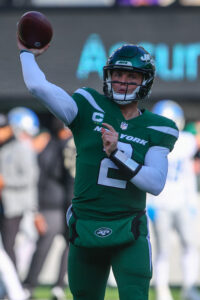 The Jets’ decision to take Sam Darnold third overall in 2018 did not prove fruitful, and in short order the team was in need of another young passer. Wilson was immediately installed as the team’s starter, but in both his rookie campaign and his follow-up season he struggled in a number of categories. A lack of improvement regarding accuracy and interception rates made it clear a more proven commodity would be required for a team internally viewed as being a quarterback away from contention.
The Jets’ decision to take Sam Darnold third overall in 2018 did not prove fruitful, and in short order the team was in need of another young passer. Wilson was immediately installed as the team’s starter, but in both his rookie campaign and his follow-up season he struggled in a number of categories. A lack of improvement regarding accuracy and interception rates made it clear a more proven commodity would be required for a team internally viewed as being a quarterback away from contention.
That drove the decision to trade for Aaron Rodgers last offseason, a move aimed at relying on the future Hall of Famer in the short term while allowing Wilson to develop as a backup. Four snaps into the season, though, Rodgers’ Achilles tear upended that plan and thrust Wilson back into a starting role. Playing behind a struggling (and injury-marred) offensive line, the BYU alum guided an offense which finished 29th in scoring and 31st in yardage. In the wake of the poor showing, owner Woody Johnson publicly disparaged Wilson in vowing to upgrade the QB2 spot.
With Tyrod Taylor now in place (and Rodgers aiming to continue playing into his 40s), Wilson’s New York days are believed to be numbered. The Jets have given him permission to seek a trade, which comes as little surprise given the team’s decision to bench him on a few occasions over the past two seasons. A fresh start for both parties could be beneficial, although value on a deal will come well short of the capital used to draft him. Offers for the 24-year-old have nevertheless been received, so a deal could be struck in relatively short order.
Once that takes place, New York will have once again cut bait with a failed QB project. Wilson could follow Darnold’s path in taking on a backup gig before receiving another starting opportunity with a new team. For the time being, though, he will aim to find the ideal supporting role in an attempt to rebuild his value.
Trey Lance (No. 3, 49ers)
Aggressively pursuing a Jimmy Garoppolo upgrade, San Francisco moved up the board at a substantial cost. The 49ers sent the Dolphins a package including three first-round picks and a third-rounder, banking on Lance’s athletic upside. After a year sitting behind Garoppolo, the North Dakota State product was positioned to take over in 2022. 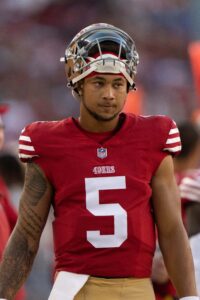
However, a Week 2 ankle fracture cut Lance’s season was cut short; this proved to mark an end to his San Francisco tenure. In all, Lance made just four regular-season starts with the 49ers, as the 2022 season unintentionally resulted in Brock Purdy taking over the starter’s role. The emergence of the former Mr. Irrelevant paved the way for Lance to be traded, but his injury history and inconsistent play when on the field limited his trade market. The Cowboys won a brief bidding war, acquiring Lance for a fourth-round pick.
Lance did not see the field in his first season as a Cowboy, but Dallas will keep him in the fold for the 2024 campaign. He will thus be in line to serve as Dak Prescott’s backup for a year; the latter is not under contract for 2025, but he remains firmly in the team’s plans. Unless Prescott were to depart in free agency next offseason, a path to a No. 1 role does not currently exist for Lance.
The 23-year-old could nevertheless still be viewed as a worthwhile developmental prospect given his age and athletic traits. The Lance acquisition has clearly proven to be a mistake on the 49ers’ part, though, especially given the success the team has had without him. What-ifs will remain a part of this 49ers chapter’s legacy (particularly if the current core cannot get over the Super Bowl hump) considering the substantial price paid to move up the board and the draft picks not available in subsequent years as a result.
Justin Fields (No. 11, Bears)
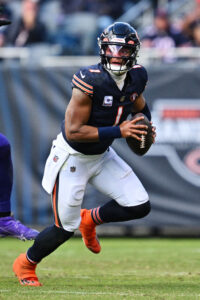 Like San Francisco, Chicago did not wait on the chance of having a top QB prospect fall down the draft board. The Bears moved two first-round picks, along fourth- and fifth-rounders, to move ahead of the Patriots and add a presumed long-term answer under center. Fields saw playing time early enough (10 starts as a rookie), but his performance that year left plenty of room for improvement.
Like San Francisco, Chicago did not wait on the chance of having a top QB prospect fall down the draft board. The Bears moved two first-round picks, along fourth- and fifth-rounders, to move ahead of the Patriots and add a presumed long-term answer under center. Fields saw playing time early enough (10 starts as a rookie), but his performance that year left plenty of room for improvement.
A head coaching change from Matt Nagy to Matt Eberflus also brought about the arrival of a new offensive coordinator (Luke Getsy). Fields did not make the expected jump as a passer in the new system, averaging less than 150 yards per game through the air and taking 55 sacks. He became only the third quarterback to record over 1,000 yards on the ground in a season, though, showcasing his rushing ability. The Ohio State product made only incremental progress in 2023, despite an improved offensive line and the trade acquisition of wideout D.J. Moore.
As a result, speculation steadily intensified that general manager Ryan Poles – who was not a member of the regime which drafted Fields – would move on from the 25-year-old. Fields received endorsements from Eberflus, Poles and others in the building, but the team decided to move on and pave the way for (in all likelihood) Caleb Williams being drafted first overall. A conditional sixth-round pick sent Fields to the Steelers, his preferred destination.
In Pittsburgh, Fields is slated to begin as the backup Russell Wilson. Both passers face uncertain futures beyond 2024, especially with the former not on track to have his fifth-year option exercised. Fields could play his way into the starter’s role in relatively short order given the 10-year age gap between he and Wilson, who flamed out in Denver. That, in turn, could see his market value jump higher than that of the other non-Lawrence members of this class given their respective situations.
Mac Jones (No. 15, Patriots)
Drafted to become the Tom Brady successor of both the short- and long-term future, Jones was immediately installed as New England’s starter. Coming off a national title with Alabama, he appeared to set the stage for a long Patriots tenure by earning a Pro Bowl nod and finishing second in Offensive Rookie of the Year voting. Nothing went according to plan for team or player beyond that point, however. 
Jones saw Josh McDaniels depart in the 2022 offseason, leaving head coach Bill Belichick to hand the offensive reins over to Matt Patricia and Joe Judge. That move resulted in widespread struggles on offense, and Jones regressed. Following a 2021 playoff berth, the inability to venture back to the postseason the following year led to increased speculation about the team’s future under center. That became particularly true amid reports of tension between Jones and Belichick.
With both coach and quarterback under pressure to rebound, optimism emerged when the Patriots hired Bill O’Brien as OC. That move did not produce the desired results, though, and by the end of the year Jones was benched in favor of Bailey Zappe. With a Belichick-less regime set to start over at the quarterback spot, the former was dealt to the Jaguars for a sixth-round pick.
Jones has publicly stated the deal (which sent him to his hometown team) was a mutual parting of ways. A backup gig behind Lawrence could allow the pocket passer to regain some of his confidence generated by his rookie success, but his showings over the past two seasons will no doubt give teams considerable pause with respect to viewing him as a starter down the road. Jones’ athletic profile is also a less favorable one than that of Wilson, Lance and especially Fields, something which could further consign him to QB2 duties for the foreseeable future.
Four quarterbacks are considered locks to hear their names called on Day 1 of the 2024 draft, one in which each of the top three picks may very well once again be used on signal-callers. Other QB prospects are also in contention for Round 1 consideration, meaning they and their new teams will be subject to considerable scrutiny. To put it lightly, all parties involved will hope the top of this year’s class pans out better than that of its 2021 counterpart.
Saints Tried To Trade Up For Mac Jones
New Orleans’ quarterback situation has not been this uncertain in more than 15 years. Injury replacement Trevor Siemian has gone 0-4 as a starter, and Taysom Hill is now battling a foot injury. With Jameis Winston tearing an ACL, the Saints will need to regroup here in 2022.
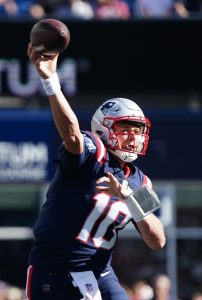 The team did try to move into the mix in last year’s five-quarterback first round, however, amid an active night of trade efforts in April. The Saints attempted to trade ahead of the Patriots with the intention of selecting Mac Jones, Jeff Howe of The Athletic notes (subscription required).
The team did try to move into the mix in last year’s five-quarterback first round, however, amid an active night of trade efforts in April. The Saints attempted to trade ahead of the Patriots with the intention of selecting Mac Jones, Jeff Howe of The Athletic notes (subscription required).
Previous reports had the Saints aiming to move up for Jaycee Horn or Patrick Surtain II, but after the Panthers and Broncos proceeded to take the draft’s top cornerbacks, it appears New Orleans made an effort to make a 10-plus-spot jump for the final first-round-graded QB. A pre-draft report linked the Saints to one of the non-Trevor Lawrence/Zach Wilson QBs in Round 1. The issue, one that hindered the Saints’ efforts to land Surtain or Horn, became teams’ unwillingness to drop down to No. 28 in a trade, Howe adds.
The Saints spoke to the Giants about moving up to No. 11, but the Bears made a better offer — a 2022 first-rounder that may land in the top 10 — to vault to that slot for Justin Fields. Following the Bears’ Fields pick, the Cowboys — after trading down two spots with the Eagles — selected Micah Parsons. The Chargers then took Rashawn Slater at No. 13. Both picks have worked out incredibly well thus far. The Vikings, who had attempted to trade up for Fields by offering third- and fourth-round picks to the Panthers at No. 8, dealt the No. 14 overall pick to the Jets, who selected Alijah Vera-Tucker. This handed the Patriots Jones, who has fared the best of this draft’s highly touted lot of quarterbacks.
The Saints made a similar move three years ago, trading up from No. 27 to No. 14 with the Packers to choose Marcus Davenport. This cost the Saints a 2018 fifth-rounder and their 2019 first-round choice. New Orleans will hold a higher first-round choice in 2022 than they did this year, but next year’s quarterback class does not feature the same level of prospects 2021’s did. This could certainly put the aggressive team in the mix for one of the veteran arms that stand to be available.
Packers Sign Third-Round WR Amari Rodgers, Finalize Draft Class
Ahead of their training camp, the Packers will have their rookie contingent signed up. For several weeks, Amari Rodgers resided as the lone unsigned Packer draftee. The team changed that Friday, inking its third-round wide receiver pick to the standard four-year rookie deal.
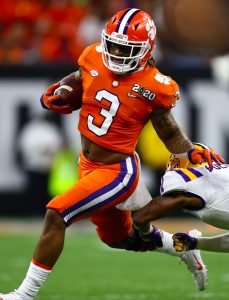 A Clemson product who played a key role on each of the Tigers’ three Trevor Lawrence-led teams, Rodgers continues the line of Green Bay Day 2 receiver investments. However, the Packers have not taken a Day 2 wideout since Ty Montgomery — whom the team reconverted to running back early in his career — in 2015. Green Bay has experienced success with second- or third-round receiver picks during the Aaron Rodgers era — Davante Adams, Randall Cobb, Jordy Nelson, James Jones, dating back to 2007 — and selected Amari Rodgers at a crucial juncture on its timeline.
A Clemson product who played a key role on each of the Tigers’ three Trevor Lawrence-led teams, Rodgers continues the line of Green Bay Day 2 receiver investments. However, the Packers have not taken a Day 2 wideout since Ty Montgomery — whom the team reconverted to running back early in his career — in 2015. Green Bay has experienced success with second- or third-round receiver picks during the Aaron Rodgers era — Davante Adams, Randall Cobb, Jordy Nelson, James Jones, dating back to 2007 — and selected Amari Rodgers at a crucial juncture on its timeline.
The Packers have major questions about the status of their passing attack. Aaron Rodgers remains AWOL, having turned down an extension offer that would have made him the NFL’s highest-paid player again. The disgruntled quarterback has not shown for Packers workouts this offseason and is not expected to report to camp on time. Adams has also become frustrated with the franchise, breaking off extension talks ahead of his contract year.
Green Bay will be deeper at receiver this season, however. Marquez Valdes-Scantling and Allen Lazard remain under contract, and 2020 free agency add Devin Funchess — a COVID-19 opt-out last year — is back in the fold.
A 5-foot-9 slot cog at Clemson, Amari Rodgers should add some juice to this aerial attack. With Tee Higgins leaving early for the NFL and Justyn Ross out for the season with an injury, Rodgers led Clemson in receiving last season en route to becoming this year’s No. 85 overall pick. He finished with 1,020 yards in 12 games, surpassing his combined total from the 2018 and ’19 seasons.
While it remains uncertain if a Rodgers-Rodgers connection will materialize, the Packers have the makings of an improved receiving corps in 2021. Here is how Green Bay’s draft class breaks down going into camp:
Round 1: No. 29 Eric Stokes, CB (Georgia) (signed)
Round 2: No. 62 Josh Myers, C (Ohio State) (signed)
Round 3: No. 85 (from Titans) Amari Rodgers, WR (Clemson) (signed)
Round 4: No. 142 Royce Newman, OG (Ole Miss) (signed)
Round 5: No. 173 Tedarrell Slaton, DT (Florida) (signed)
Round 5: No. 178 Shemar Jean-Charles, CB (Appalachian State) (signed)
Round 6: No. 214 Cole Van Lanen, G (Wisconsin) (signed)
Round 6: No. 220 Isaiah McDuffie, LB (Boston College) (signed)
Round 7: No. 256 Kylin Hill, RB (Mississippi State) (signed)
Raiders Sign Third-Rounders Malcolm Koonce, Divine Deablo To Wrap Draft Class
The Raiders are ready to roll for training camp; all their rookies are now under contract. Las Vegas came to terms on the customary four-year rookie deals for third-round picks Divine Deablo and Malcolm Koonce on Friday.
Las Vegas took Koonce, a defensive end out of Buffalo, at No. 79 before drafting Deablo (Virginia Tech) a pick later. The team is set to open its training camp July 27, joining 28 other squads in that regard. Deablo, Koonce and second-round safety Trevon Moehrig represent the Raiders’ Day 2 draft contingent. Moehrig signed his rookie deal last month.
Primarily a safety at Virginia Tech, Deablo is on track to begin his NFL career as a linebacker. Deablo began his Hokies career as a wide receiver, ranking as a top-25 wideout recruit nationally in 2016, but moved to the defensive side in 2017. Deablo was a key Virginia Tech defender from 2018-20. Last season, he intercepted four passes; one of those picks came against top 2021 pick Trevor Lawrence. Deablo will join an experienced Raiders linebacking corps, being positioned to potentially see extensive time following the 2021 season.
Koonce combined to register 13 sacks over the past two seasons. He tallied 11 tackles for loss in 2019, when he added three forced fumbles. Koonce finished as a first-team All-MAC defender during the conference’s six-game season. In that truncated campaign, Koonce still posted five sacks. He will join a Raiders edge-rushing corps that now houses Yannick Ngakoue, who signed to team with Clelin Ferrell and former fourth-round find Maxx Crosby. Crosby was also a MAC pass-rushing standout.
Going into camp, here is how the Raiders’ 2021 draft class breaks down:
Round 1: No. 17 Alex Leatherwood, OL (Alabama) (signed)
Round 2: No. 43 (from 49ers) Tre’von Moehrig, S (TCU) (signed)
Round 3: No. 79 (from Cardinals) Malcolm Koonce, DE (Buffalo) (signed)
Round 3: No. 80 Divine Deablo, S (Virginia Tech) (signed)
Round 4: No. 143 (from Vikings via Jets) Tyree Gillespie, S (Missouri) (signed)
Round 5: No. 167 (from Seahawks) Nate Hobbs, CB (Illinois) (signed)
Round 7: No. 230 (from Jets via 49ers) Jimmy Morrissey, C (Pittsburgh) (signed)
Dolphins Sign Second-Round S Jevon Holland
The first of the Dolphins’ two second-round picks is now under contract. The Dolphins and safety Jevon Holland agreed to terms on the customary four-year rookie deal Friday.
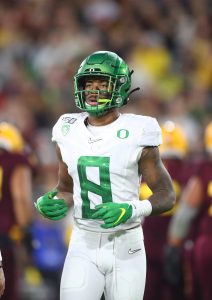 Miami selected Holland 36th overall out of Oregon, doing so just after Denver traded up to No. 35 to take running back Javonte Williams. The Dolphins did extensive work on Williams, but after the Broncos’ move, the team’s focus shifted. Holland will be ticketed to play a key role in Miami’s secondary as a rookie.
Miami selected Holland 36th overall out of Oregon, doing so just after Denver traded up to No. 35 to take running back Javonte Williams. The Dolphins did extensive work on Williams, but after the Broncos’ move, the team’s focus shifted. Holland will be ticketed to play a key role in Miami’s secondary as a rookie.
The Dolphins cut longtime starter Bobby McCain this offseason, clearing a path for Holland to move into the starting lineup as a rookie. Miami has converted cornerback Eric Rowe in position as a safety starter. Rowe has been a full-time safety first-stringer in each of Brian Flores‘ two seasons.
Holland opted out last year, joining Oregon first-round talent Penei Sewell in doing so, but the 6-foot, 207-pound defender packed plenty into his two-year Ducks sample. Holland intercepted nine passes in his two years with the Ducks. He added 4.5 tackles for loss as a sophomore in 2019.
Both of Miami’s other Day 2 picks — second-round tackle Liam Eichenberg and third-round tight end Hunter Long — remain unsigned. The Dolphins and first-rounders Jaelan Phillips and Jaylen Waddle have agreed to terms.
Broncos Sign Second-Round RB Javonte Williams
With Broncos rookies reporting Saturday, they will have their entire draft class ready for training camp. Second-round pick Javonte Williams signed his four-year rookie deal Friday, becoming the last of Denver’s 10 2021 draftees to sign.
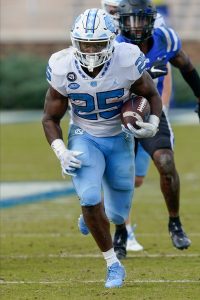 New Broncos GM George Paton traded up in front of the Dolphins at No. 35 to draft Williams, who teamed with Jets fourth-rounder Michael Carter to form one of the nation’s top backfields. Williams entered the draft as Pro Football Focus’ No. 1-rated back; he went off the board third at the position, behind first-rounders Najee Harris and Travis Etienne. Williams doubles as the Broncos’ highest-drafted back since Knowshon Moreno in the 2009 first round.
New Broncos GM George Paton traded up in front of the Dolphins at No. 35 to draft Williams, who teamed with Jets fourth-rounder Michael Carter to form one of the nation’s top backfields. Williams entered the draft as Pro Football Focus’ No. 1-rated back; he went off the board third at the position, behind first-rounders Najee Harris and Travis Etienne. Williams doubles as the Broncos’ highest-drafted back since Knowshon Moreno in the 2009 first round.
Williams, who averaged 7.3 yards per carry in his third and final North Carolina season, scored 22 touchdowns in 2020. He amassed 1,445 scrimmage yards despite the COVID-19 pandemic capping the Tar Heels’ season at 11 games. His Denver arrival figures to signal Melvin Gordon will be a two-and-done back with the team — at best.
The Broncos, despite Phillip Lindsay‘s back-to-back 1,000-yard seasons, gave Gordon a two-year deal worth $16MM in March 2020. Gordon played well in spurts but also fumbled four times and was arrested for DUI last year. That charge ultimately being dismissed kept Gordon’s guarantees intact, but his 2021 roster spot may not be locked in. Though Lindsay is now in Houston, the Broncos signed ex-Vikings backup Mike Boone this offseason. It would cost the Broncos $6.5MM in dead money to cut Gordon.
NFL Draft Pick Signings: 7/22/21
We’ll keep track of today’s later round signings here:
Denver Broncos
- LB Baron Browning (third-round, Ohio State)
Los Angeles Rams
- LB Ernest Jones (third-round, South Carolina)
Tennessee Titans
- CB Elijah Molden (third-round, Washington)
Latest On Unsigned Third-Round Picks
A significant number of third-round picks have yet to ink their rookie contracts, and SiriusXM’s Adam Caplan has a potential explanation. The reporter tweets that these rookies’ agents are requesting a fully compensated four-year deal.
Specifically, agents want to max out base salaries (while adhering to the 25-percent limit). Front offices apparently aren’t giving in; there are currently 26 unsigned third-round picks (h/t to John Glennon of Broadway Sports on Twitter). For comparison’s sake, there are eight unsigned second-round picks and zero unsigned fourth-round picks.
This trend may have been inspired by Nico Collins. The Texans rookie wideout ended up inking the “fully compensated” four-year deal. The Michigan product was the 25th pick of the third round (No. 89 overall), so it’s easy to assume that most of the players taken before Collins are pushing for a similar contract.
That 25-percent rule is the true crux of the staring contests between teams and agents. Per NFL.com, the rule states that “[u]nless a player’s base salary is set at the minimum every year, no team can sign a player to a contract that would give him a raise of more than 25 percent annually. So, the second year of the contract can’t provide a salary more than 25 percent of the first year, and after that, each subsequent year can’t offer an increase of more than 25 percent of his previous year’s salary.” The difference between that aforementioned “minimum” third-round contract and the hypothetical “maximum” third-round contract is about $500K for the life of the contract, a significant sum at that point in the draft.
Eight Second-Rounders, 27 Third-Rounders Still Unsigned
Even though there hasn’t been much drama in rookie contract negotiations since the 2011 collective bargaining agreement was passed, there are always a few stragglers when it comes to getting rookie deals signed. As of the time of this writing, eight 2021 second-rounders (including the top six picks of the second round) are still unsigned, and 27 third-rounders have yet to put pen to paper.
An NFL executive (via Ryan O’Halloran of the Denver Post) offers a refresher on why this is the case. He reminds us that most second-round choices now have the second year of their rookie deals guaranteed, and those players are pushing for more guarantees in the third year of their contracts. So, if the first pick of the second round has 90% of his third year guaranteed, the second pick of the round might get an 85% guarantee, and so on. That helps explain why, after the top six selections of the round, there are only two unsigned draftees.
The third round is the opposite. The first 12 third-rounders (pick nos. 65-76) are signed, whereas only two players selected with the nos. 77-105 picks are under contract. That is because, starting in the third round, teams don’t have to pay their rookies the full 25% yearly salary increase the CBA permits. The players’ agents, of course, are negotiating to get their clients as close to that 25% figure as possible, but as the executive notes, most of these discussions are revolving around a few thousand dollars at this point.
Every player drafted from rounds 4-7 is under contract, and there are still six unsigned first-rounders. Here’s the list of second- and third-round players who are still waiting to sign on the dotted line with several weeks left until training camp opens.
Round 2
33) Jacksonville Jaguars: Tyson Campbell, CB (Georgia)
34) New York Jets: Elijah Moore, WR (Ole Miss)
35) Denver Broncos (from Falcons): Javonte Williams, RB (North Carolina)
36) Miami Dolphins (from Texans): Jevon Holland, S (Oregon)
37) Philadelphia Eagles: Landon Dickerson, C (Alabama)
38) New England Patriots (from Bengals): DT Christian Barmore (Alabama)
42) Miami Dolphins (from Giants): Liam Eichenberg, OT (Notre Dame)
45) Jacksonville Jaguars (from Vikings): Walker Little, OT (Stanford)
Round 3
77) Los Angeles Chargers: Josh Palmer, WR (Tennessee)
78) Minnesota Vikings: Chazz Surratt, LB (North Carolina)
79) Las Vegas Raiders (from Cardinals): Malcolm Koonce, DE (Buffalo)
80) Las Vegas Raiders: Divine Deablo, S (Virginia Tech)
81) Miami Dolphins: Hunter Long, TE (Boston College)
83) Carolina Panthers (from Bears): Tommy Tremble, TE (Notre Dame)
84) Dallas Cowboys (from Eagles via Colts): Chauncey Golston, DE (Iowa)
85) Green Bay Packers (from Titans): Amari Rodgers, WR (Clemson)
86) Minnesota Vikings (from Seahawks via Jets): Wyatt Davis, G (Ohio State)
87) Pittsburgh Steelers: Kendrick Green, C (Illinois)
88) San Francisco 49ers (from Rams): Trey Sermon, RB (Ohio State)
90) Minnesota Vikings (from Ravens): Patrick Jones II, DE (Pittsburgh)
91) Cleveland Browns (from Saints): Anthony Schwartz, WR (Auburn)
92) Tennessee Titans (from Packers): Monty Rice, LB (Georgia)
93) Buffalo Bills: Spencer Brown, OT (Northern Iowa)
94) Baltimore Ravens (from Chiefs): Ben Cleveland, G (Georgia)
95) Tampa Bay Buccaneers: Robert Hainsey, OL (Notre Dame)
96) New England Patriots (compensatory pick): Ronnie Perkins, DE (Oklahoma)
97) Los Angeles Chargers (compensatory pick): Tre’ McKitty, TE (Georgia)
98) Denver Broncos (compensatory pick, from Saints): Quinn Meinerz, G (Wisconsin-Whitewater)
99) Dallas Cowboys (compensatory pick): Nahshon Wright, CB (Oregon State)
100) Tennessee Titans (compensatory pick): Elijah Molden, CB (Washington)
101) Detroit Lions (from Rams, compensatory pick): Ifeatu Melifonwu, CB (Syracuse)
102) San Francisco 49ers (compensatory pick): Ambry Thomas, CB (Michigan)
103) Los Angeles Rams (compensatory pick): Ernest Jones, LB (South Carolina)
104) Baltimore Ravens (compensatory pick): Brandon Stephens, CB (SMU)
105) Denver Broncos (compensatory pick, from Saints), Baron Browning, LB (Ohio State)
